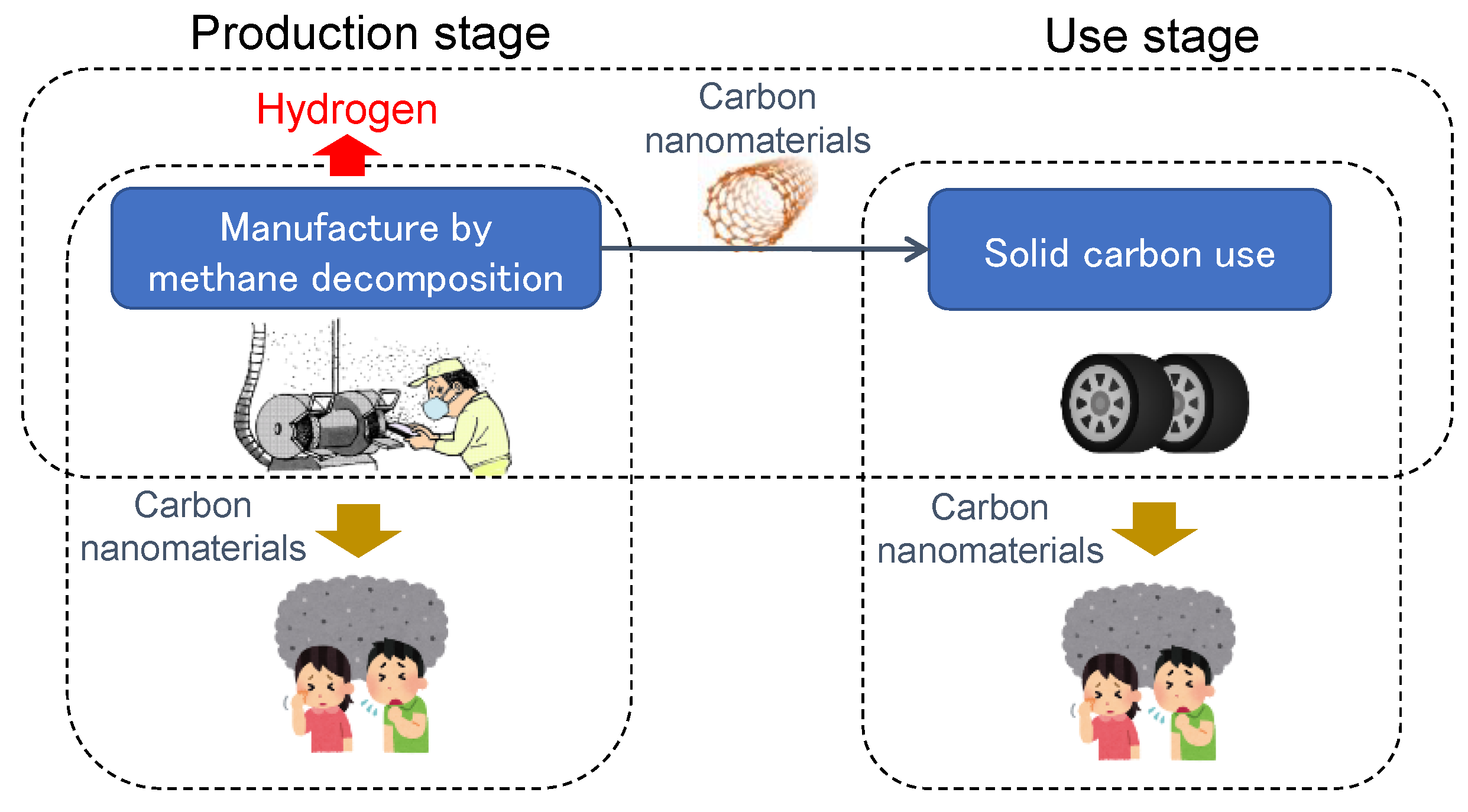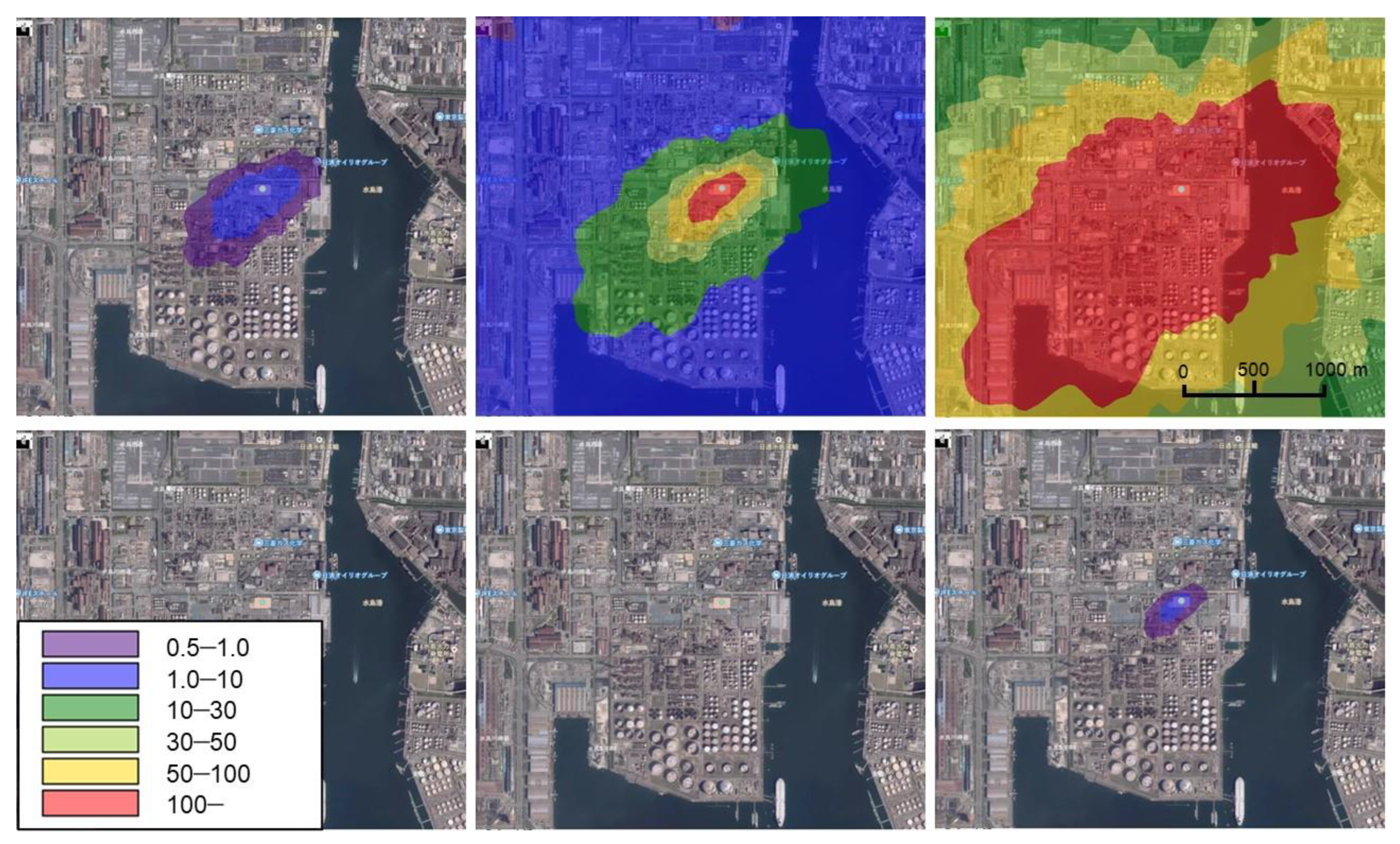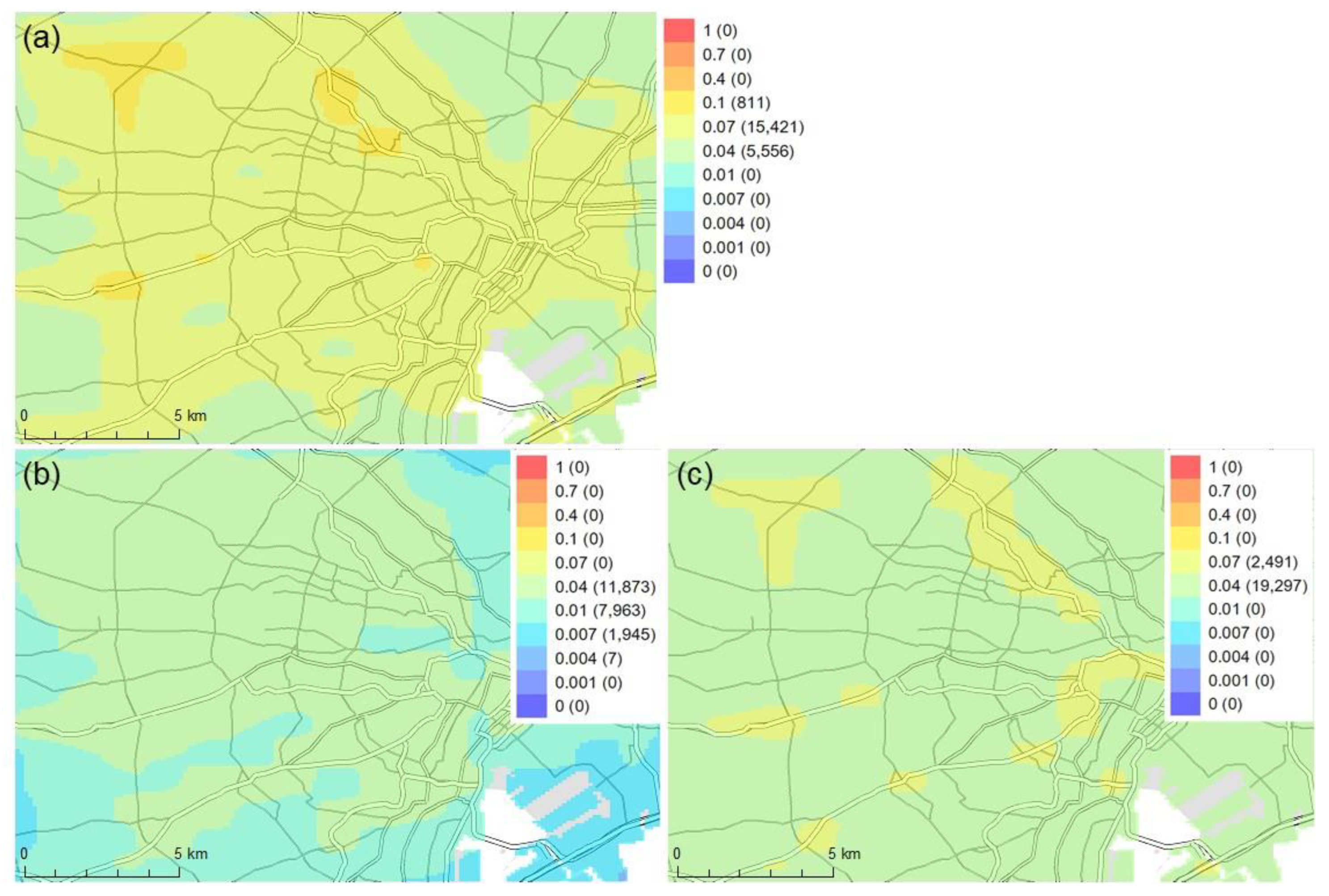Screening Risk Assessment at the Production and Use Stage of Carbon Nanomaterials Generated in Hydrogen Manufacture by Methane Decomposition
Abstract
:1. Introduction
2. Materials and Methods
2.1. Emissions from Production
2.2. Emissions from Usage
2.3. Model Calculation
2.4. Toxicity and Screening Assessment
3. Result
3.1. Production Stage
3.2. Use Stage
4. Discussion
5. Conclusions
Author Contributions
Funding
Institutional Review Board Statement
Informed Consent Statement
Data Availability Statement
Conflicts of Interest
References
- Abbas, H.F.; Daud, W.M.A.W. Hydrogen production by methane decomposition: A review. Int. J. Hydrogen Energy 2010, 35, 1160–1190. [Google Scholar] [CrossRef]
- Amin, A.M.; Croiset, E.; Epling, W. Review of methane catalytic cracking for hydrogen production. Int. J. Hydrogen Energy 2010, 36, 2904–2935. [Google Scholar] [CrossRef]
- Abánades, A.; Rubbia, C.; Salmieri, D. Technological challenges for industrial development of hydrogen production based on methane cracking. Energy 2012, 46, 359–363. [Google Scholar] [CrossRef]
- Zhou, L.; Enakonda, L.R.; Harb, M.; Saih, Y.; Aguilar-Tapia, A.; Ould-Chikh, S.; Hazemann, J.L.; Li, J.; Wei, N.; Gary, D.; et al. Fe catalysts for methane decomposition to produce hydrogen and carbon nano materials. Appl. Catal. B Environ. 2017, 208, 44–59. [Google Scholar] [CrossRef] [Green Version]
- Zhou, L.; Enakonda, L.R.; Li, S.; Gary, D.; Del-Gallo, P.; Mennemann, C.; Basset, J.M. Iron ore catalysts for methane decomposition to make CO x free hydrogen and carbon nano material. J. Taiwan Inst. Chem. Eng. 2018, 87, 54–63. [Google Scholar] [CrossRef]
- Pinilla, J.L.; Moliner, R.; Suelves, I.; Lazaro, M.J.; Echegoyen, Y.; Palasios, J.M. Production of hydrogen and carbon nanofibers by decomposition of methane using metal catalysts in a fluidized bed reactor. Int. J. Hydrogen Energy 2007, 32, 4821–4829. [Google Scholar] [CrossRef]
- Yeheskel, J.; Epstein, M. Thermolysis of methane in a solar reactor for mass-production of hydrogen and carbon nano-materials. Carbon 2011, 49, 4695–4703. [Google Scholar] [CrossRef]
- Nakanishi, J. (Ed.) Risk Assessment of Manufactured Nanomaterials—Carbon Nanotubes (CNT)—Final Report, Executive Summary, Research and Development of Nanoparticle Characterization Methods (P06041). Available online: https://riss.aist.go.jp/en/research-outcomes/339/ (accessed on 12 April 2022).
- NIOSH. Occupational Exposure to Carbon Nanotubes and Nanofibers. In Current Intelligence Bulletin; National Institute for Occupational Safety and Health: Washington, DC, USA, 2013; Volume 65. Available online: https://www.cdc.gov/niosh/docs/2013-145/pdfs/2013-145.pdf?id=10.26616/NIOSHPUB2013145 (accessed on 12 April 2022).
- Stone, V.; Hankin, S.; Aitken, R.; Aschberger, K.; Baun, A.; Christensen, F.; Fernandes, T.; Hansen, S.F.; Hartmann, N.B.; Hutchinson, G.; et al. Engineered Nanoparticles: Review of Health and Environmental Safety (ENRHES) 2009. Available online: https://www.safenano.org/media/109923/ENRHES-Final%20version.pdf (accessed on 12 April 2022).
- Pauluhn, J. Multi-walled carbon nanotubes (Baytubes): Approach for derivation of occupational exposure limit. Regul. Toxicol. Pharmacol. 2010, 57, 78–89. [Google Scholar] [CrossRef]
- Luizi, F. Responsible Care and Nanomaterials—Case Study Nanocyl. In Proceedings of the European Responsible Care Conference, Prague, Czech Republic, 21–23 October 2009. [Google Scholar]
- Aschberger, K.; Micheletti, C.; Sokull-Klüttgen, B.; Christensen, F.M. Analysis of currently available data for characterizing the risk of engineered nanomaterials to the environment and human health—Lessons learned from four case studies. Environ. Int. 2011, 37, 1143–1156. [Google Scholar] [CrossRef]
- Meesters, J.A.; Koelmans, A.A.; Quik, J.T.K.; Hendriks, A.J.; Meent, D.V.D. Multimedia modeling of engineered nanoparticles with SimpleBox4nano: Model definition and evaluation. Environ. Sci. Technol. 2014, 48, 5726–5736. [Google Scholar] [CrossRef]
- Liu, H.H.; Cohen, Y. Multimedia environmental distribution of engineered nanomaterials. Environ. Sci. Technol. 2014, 48, 3281–3292. [Google Scholar] [CrossRef]
- Kouchi, A.; Okabayashi, K.; Okamoto, S.; Yoshikado, H.; Yamamoto, S.; Kobayashi, K.; Ono, N.; Koizumi, M. Development of a low-rise industrial source dispersion model (METI-LIS model). Int. J. Environ. Pollut. 2004, 21, 325–338. [Google Scholar] [CrossRef]
- Higashino, H.; Kitabayashi, K.; Inoue, K.; Mita, K.; Yonezawa, Y. Development of an atmospheric dispersion model for exposure and risk assessment (AIST-ADMER). J. Jpn. Soc. Atmos. Environ. 2003, 38, 100–115. (In Japanese) [Google Scholar]
- Fujitani, Y.; Kobayashi, T.; Arashidani, K.; Kunugita, N.; Suemura, K. Measurement of the physical properties of aerosols in a fullerene factory for inhalation exposure assessment. J. Occup. Environ. Hyg. 2008, 5, 380–389. [Google Scholar] [CrossRef]
- Yeganeh, B.; Kull, C.M.; Hull, M.S.; Marr, L.C. Characterization of airborne particles during production of carbonaceous nanomaterials. Environ. Sci. Technol. 2008, 42, 4600–4606. [Google Scholar] [CrossRef]
- Lee, J.H.; Lee, S.-B.; Bae, G.N.; Jeon, K.S.; Yoon, J.U.; Ji, J.H.; Sung, J.H.; Lee, B.G.; Lee, J.H.; Yang, J.S.; et al. Exposure assessment of carbon nanotube manufacturing workplaces. Inhal. Toxicol. 2010, 22, 369–381. [Google Scholar] [CrossRef]
- Shinohara, N. (Ed.) Risk Assessment of Manufactured Nanomaterials—Fullerene (C60)—Final Report, Executive Summary, Research and Development of Nanoparticle Characterization Methods (P06041). Available online: https://riss.aist.go.jp/en/research-outcomes/339/ (accessed on 12 April 2022).
- Keller, A.A.; McFerran, S.; Lazareva, A.; Suh, S. Global life cycle releases of engineered nanomaterials. J. Nanoparticle Res. 2013, 15, 1692. [Google Scholar] [CrossRef]
- U.S. EPA. What Is a HEPA Filter? Available online: https://www.epa.gov/indoor-air-quality-iaq/what-hepa-filter-1 (accessed on 12 April 2022).
- Ministry of the Environment. Environmental Effect Prevention Guidelines Pertaining to Industrial Nanomaterials, March 2009 Nanomaterials Environmental Impact Basic Investigation Study Group. Available online: https://www.env.go.jp/chemi/nanomaterial/eibs-conf/guideline_0903_enab.pdf (accessed on 12 April 2022).
- Japan Environmental Sanitation Center. Report of Results of Contract Work Investigations of the MoE in 2005, Investigation of Pollution Contribution of Road Dust, etc., March 2006; Japan Environmental Sanitation Center: Kawasaki, Kanagawa, Japan, 2006. (In Japanese) [Google Scholar]
- The Japan Automobile Tyre Manufacturers Association, Inc. Tyre LCCO2 Calculation Guidelines Ver. 2.0; The Japan Automobile Tyre Manufacturers Association, Inc.: Tokyo, Japan, 2012; Available online: https://www.jatma.or.jp/english/tyrerecycling/pdf/lcco2guideline_en.pdf (accessed on 12 April 2022).
- Ministry of the Economy, Trade and Industry/Ministry of the Environment. Details of 2007 Estimation Method for PRTR Non-Reported Emissions. Available online: https://www.env.go.jp/chemi/prtr/result/todokedegaiH19/syosai.html (accessed on 12 April 2022). (In Japanese)
- Florea, A.; Lorint, C.; Danciu, C. Particulate matters generated by caprisoara tailing pond and their impact on air quality. Environ. Eng. Manag. J. 2019, 18, 803–810. [Google Scholar] [CrossRef]
- Khandadakar, M.; Moritomi, H. Modeling of atmospheric dispersion of mercury from coal–fired power plants in Japan. Atmos. Pollut. Res. 2012, 3, 226–237. [Google Scholar] [CrossRef] [Green Version]
- Ruan, S.L.; Gao, P.; Yang, X.G.; Yu, T.X. Toughening high performance ultrahigh molecular weight polyethylene using multiwalled carbon nanotubes. Polymer 2003, 44, 5643–5654. [Google Scholar] [CrossRef]
- Wei, F.; Zhang, Q.; Qian, W.Z.; Yu, H.; Wang, Y.; Luo, G.H.; Xu, G.H.; Wang, D.Z. The mass production of carbon nanotubes using a nano-agglomerate. Powder Technol. 2008, 183, 10–20. [Google Scholar] [CrossRef]
- Son, S.Y.; Lee, Y.; Won, S.; Lee, D.H. High-quality multiwalled carbon nanotubes from catalytic decomposition of carboneous materials in gas-solid fluidized beds. Ind. Eng. Chem. Res. 2008, 47, 2166–2175. [Google Scholar] [CrossRef]
- Dahm, M.M.; Schubauer-Berigan, M.K.; Evans, D.E.; Birch, M.E.; Fernback, J.E.; Deddens, J.A. Carbon Nanotube and Nanofiber Exposure Assessments: An Analysis of 14 Site Visits. Ann. Occup. Hyg. 2015, 59, 705–723. [Google Scholar] [CrossRef]
- National Institute of Advanced Industrial Science and Technology. Technical Guidance for Detailed Risk Assessment, Part 3, February 2006. Available online: https://unit.aist.go.jp/riss/crm/mainmenu/tech_guidance03.pdf (accessed on 12 April 2022). (In Japanese)
- Lan, B.N.T.; Kobayashi, T.; Suetsugu, A.; Tian, X.; Kameya, T. Estimating the possibility of surface soil pollution with atmospheric lead deposits using the ADMER model. Sustainability 2018, 10, 720. [Google Scholar]
- Latha, K.M.; Badarinath, K.V.S.; Reddy, P.M. Scavenging efficiency of rainfall on black carbon aerosols over an urban environment. Atmos. Sci. Lett. 2005, 6, 148–151. [Google Scholar] [CrossRef]
- Andronache, C. Estimated variability of below-cloud aerosol removal by rainfall for observed aerosol size distributions. Atmos. Chem. Phys. 2003, 3, 131–143. [Google Scholar] [CrossRef] [Green Version]
- Panko, J.M.; Hitchcock, K.M.; Fuller, G.W.; Green, D. Evaluation of tire wear contribution to PM2.5 in urban environments. Atmosphere 2019, 10, 99. [Google Scholar] [CrossRef] [Green Version]
- Kanto Chemical Co., Inc. Single-Walled Carbon Nanotube. Available online: https://products.kanto.co.jp/products/siyaku/pdf/s_nanointegris_ODA-01.pdf (accessed on 24 May 2022). (In Japanese).




| Emission Factor | Filtering | Emission Volume, t/y (kg/h 1) | ||
|---|---|---|---|---|
| Small-Scale Factory | Medium-Scale Factory | Large-Scale Factory | ||
| 0.1% | W/o Filter | 1 (0.11) | 53 (6.1) | 1000 (114) |
| W/ Filter | <3.0 × 10−4 (<3.4 × 10−5) | <0.016 (<1.8 × 10−3) | <0.3 (<0.034) | |
| 0.8% | W/o Filter | 8 (0.91) | 424 (48) | 8000 (913) |
| W/ Filter | <0.0024 (<2.7 × 10−4) | <0.13 (<0.015) | <2.4 (<0.27) | |
| Vehicle Type | Tire Wear Rate 1 (g/km·Vehicle) | Solid Carbon Content 2 (g-C/g-Tire Particulates) | Nationwide Annual Travel Volume 3 (Million km/Year) | Nationwide Annual Atmospheric Emission Volume (T/Year) | Emission Coefficient (g/s/(Vehicle ·km/h)) |
|---|---|---|---|---|---|
| Motorcycles | 1.75 × 10−4 | 0.22 | 15,191 | 0.58 | 1.07 × 10−8 |
| Passenger cars | 3.50 × 10−4 | 520,138 | 40.05 | 2.14 × 10−8 | |
| Buses | 5.90 × 10−3 | 6650 | 8.63 | 3.61 × 10−7 | |
| Light trucks | 3.50 × 10−4 | 68,271 | 5.26 | 2.14 × 10−8 | |
| General cargo trucks | 5.90 × 10−3 | 79,607 | 103.33 | 3.61 × 10−7 |
| Item | Model Input Parameter | Note |
|---|---|---|
| Molecular weight | 6 × 106 g/mol | Ruan et al., 2003 [30] |
| Particle diameter/mass ratio | <10 µm: 20 w/w%, 10–50 µm: 80 w/w% | Dahm et al., 2015 [33] |
| Resistance correction coefficient | 1.32 | Particle shape: cylindrical, axial length ratio 4 |
| Bulk density | 40 kg/m3 | Wei et al., 2008 [31] |
| Item | Content |
|---|---|
| Model | METI–LIS ver. 3.4.2 |
| Life cycle | Hydrogen production by methane decomposition |
| Boundary | The area of the Seto Inland Sea of Western Japan |
| Physical property | See Table 3 |
| Emission | Setting of emissions by production scales and with/without filters (see Table 3) |
| Actual smokestack height | 5 m |
| Stack chip/down wash | Not considered |
| Increased buoyancy | Not considered |
| Meteorological data period | 1 January 2005–31 December 2005 |
| Calculation point height | 1.5 m |
| Item | Content |
|---|---|
| Model | AIST–ADMER ver. 3.5 |
| Life cycle | Tire use of solid carbon |
| Boundary | 15 km2 grid around central Tokyo |
| Grid size | 100 m |
| Distribution index | Traffic volume in 2005 (100 m grid), weekday, gasoline/diesel Vehicle type: motorcycles, passenger cars, buses, light trucks, general cargo trucks |
| Emission volume | Setting of emission coefficients by vehicle type (see Table 3) |
| Exhaust height | 1 m |
| Decomposition coefficient | 0/s |
| Scavenging ratio | 1.23 × 105 |
| Background concentration | 0 µg/m3 |
| Meteorological data period | 1 January 2005–31 December 2005 |
| Reference | Material | Permissible Exposure Concentration, etc. (µg/m3) | Note |
|---|---|---|---|
| Nakanishi, 2011 [8] | CNT | 30 (inhalant dust) | This is the assumed subchronic exposure value of 15 y at 8 h per day. |
| NIOSH, 2013 [9] | CNT/CNF | 1 (inhalant dust) | Recommended exposure limit (REL), TWA (time-weighted average) |
| Stone et al., 2009 [10] | CNT | 0.7–30 | Derived no-effect level (DNEL) |
| Pauluhn, 2010 [11] | Multilayer CNT, Bayer | 50 | Occupational exposure limit (OEL), TWA |
| Luizi, 2009 [12] | Multilayer CNT, Nanocyl | 2.5 | - |
| Aschberger et al., 2011 [13] | CNT | 1–2 | Indicative no-effect level (INEL) |
| Emission Factor | Filtering | Maximum Concentration of Solid Carbon in the Air (µg/m3) | ||
|---|---|---|---|---|
| Small-Scale Factory | Medium-Scale Factory | Large-Scale Factory | ||
| 0.1% | W/o Filter | 6.80 | 380 | 7100 |
| W/ Filter | <0.0021 | <0.11 | <2.1 | |
| 0.8% | W/o Filter | 57 | 3000 | 57,000 |
| W/ Filter | <0.017 | <0.93 | <17 | |
| Vehicle Type | Concentration of Solid Carbon in the Air (µg/m3) | ||
|---|---|---|---|
| Minimum | Maximum | Average | |
| Motorcycles | 1.28 × 10−4 | 9.96 × 10−4 | 4.82 × 10−4 |
| Passenger cars | 3.55 × 10−3 | 1.83 × 10−2 | 1.04 × 10−2 |
| Buses | 9.68 × 10−4 | 6.00 × 10−3 | 2.67 × 10−3 |
| Light trucks | 1.12 × 10−3 | 7.89 × 10−3 | 3.09 × 10−3 |
| General cargo trucks | 1.48 × 10−2 | 5.86 × 10−2 | 3.06 × 10−2 |
| All vehicle types | 2.06 × 10−2 | 8.67 × 10−2 | 4.72 × 10−2 |
Publisher’s Note: MDPI stays neutral with regard to jurisdictional claims in published maps and institutional affiliations. |
© 2022 by the authors. Licensee MDPI, Basel, Switzerland. This article is an open access article distributed under the terms and conditions of the Creative Commons Attribution (CC BY) license (https://creativecommons.org/licenses/by/4.0/).
Share and Cite
Tsunemi, K.; Yoshida, M.; Kawamoto, A. Screening Risk Assessment at the Production and Use Stage of Carbon Nanomaterials Generated in Hydrogen Manufacture by Methane Decomposition. Sustainability 2022, 14, 6700. https://doi.org/10.3390/su14116700
Tsunemi K, Yoshida M, Kawamoto A. Screening Risk Assessment at the Production and Use Stage of Carbon Nanomaterials Generated in Hydrogen Manufacture by Methane Decomposition. Sustainability. 2022; 14(11):6700. https://doi.org/10.3390/su14116700
Chicago/Turabian StyleTsunemi, Kiyotaka, Madoka Yoshida, and Akemi Kawamoto. 2022. "Screening Risk Assessment at the Production and Use Stage of Carbon Nanomaterials Generated in Hydrogen Manufacture by Methane Decomposition" Sustainability 14, no. 11: 6700. https://doi.org/10.3390/su14116700






